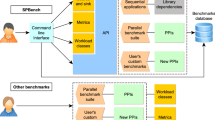Abstract
In modern VLSI technology, hundreds of thousands of arithmetic units fit on a 1cm2 chip. The challenge is supplying them with instructions and data. Stream architecture is able to solve the problem well. However, the applications suited for typical stream architecture are limited. This paper presents the definition of regular stream and irregular stream, and then describes MASA (Multiple-morphs Adaptive Stream Architecture) prototype system which supports different execution models according to applications' stream characteristics. This paper first discusses MASA architecture and stream model, and then explores the features and advantages of MASA through mapping stream applications to hardware. Finally MASA is evaluated by ten benchmarks. The result is encouraging.
Similar content being viewed by others
References
2003 Workshop on Streaming Systems. http://catfish.csail.mit.edu/wss03/.
Mark Horowitz et al. Scaling computers: Why streaming is interesting. In 2003 Workshop on Streaming Systems, Dedham, Massachusetts, 2003.
Rixner S et al. A bandwidth-efficient architecture for media processing. In 31st Int. Symp, Microarchitecture, IEEE Computer Society Press, 1998, pp.3–13.
Zhibo Chen, Peng Zhou, Yun He. Fast integer pel and fractional pel motion estimation for JVT. In Jaint Video Team (JVT) of ISO/IEC MPEG&ITU-T VCEG, JVT-F017 6th Meeting, Awaji, December 2002.
Haiyan Li, Mei Wen, Nan Wu et al. Accelerated motion estimation of H.264 on Imagine stream processor. In Int. Conf. Image Analysis and Recognition 2005, Toronto, 2005.
ATI technologies Inc. Radeon whitepape, 2000.
Khailany B, Dally W J et al. Imagine: Media processing with streams. IEEE Micro., 2001, (3/4): 35–46.
Kapasi U J, Dally W J et al. The Imagine stream processor. In Proc. 2002 International Conference on Computer Design, 2002, Freiburg, Germany, pp.282–288.
Kapasi U J et al. Programmable stream processor. IEEE Computer, Aug. 2003, pp.54–62.
Kapasi U J. Conditional techniques for stream processing kernels [Dissertation]. Dept. Electrical Engineering, Stanford University, 2004.
Taylor M B et al. Evaluation of the raw microprocessor: An exposed-wire-delay architecture for ILP and streams. In ISCA2004, München, Germany.
Taylor M B et al. The raw microprocessor: A computational fabric for software circuits and general purpose programs. IEEE Micro., 2002, (3/4).
Karthikeyan Sankaralingam et al. Exploiting ILP, TLP, and DLP with the polymorphous TRIPS architecture. In 30th Annual Int. Symp. Computer Architecture, May 2003.
Mai K et al. Smart memories: A modular reconfigurable architecture. In 2000 ISCA, Vancouver, Canada, pp.161–171.
Karthikeyan Sankaralingam et al. Universal mechanism for data-parallel architectures. In Proc. the 36th International Symposium on Microarchitecture, IEEE, 2003.
Brucek Khailany et al. Exploring the VLSI scalability of stream processors. In Proc. the Ninth Symposium on High Performance Computer Architecture, California, 2003.
Peter Mattson. A programming system for the imagine media processor [Dissertation]. Standford University, 2001.
Zhengyu Tian. Numerical simulations of multiplex unsteady flow in hypersonic free stream [Thesis]. Dept. Aerospace and Material Engineering, National University of Defense Technology, Dec. 2003.
Mei Wen, Nan Wu et al. A parallel Reed-Solomon decoder on the Imagine stream processor. In 2nd Int. Symp. Parallel and Distributed Processing and Applications, Hongkong, 2004, pp.28–33.
Jung Ho Ahn et al. Evaluating the Imagine stream architecture. In ISCA2004, M¨nchen, Germany.
Author information
Authors and Affiliations
Corresponding author
Additional information
This research was supported by the National Natural Science Foundation of China (Grant No.60473080).
Mei Wen is a Ph.D. candidate in computer science at National University of Defense Technology. Her research interests include computer architecture and scientific computing.
Nan Wu is a Ph.D. candidate in computer science at National University of Defense Technology. His research interests include computer architecture, stream computing and compiler design.
Hai-Yan Li is a Ph.D. candidate in computer science at National University of Defense Technology. Her research interests include computer architecture and media processing.
Chun-Yuan Zhang is a professor of computer science at National University of Defense Technology. His research interests include multicomputer architecture and scientific computing. He received the Ph.D. degree in computer science from National University of Defense Technology.
Rights and permissions
About this article
Cite this article
Wen, M., Wu, N., Li, HY. et al. Multiple-Morphs Adaptive Stream Architecture. J Comput Sci Technol 20, 635–646 (2005). https://doi.org/10.1007/s11390-005-0635-7
Revised:
Issue Date:
DOI: https://doi.org/10.1007/s11390-005-0635-7




